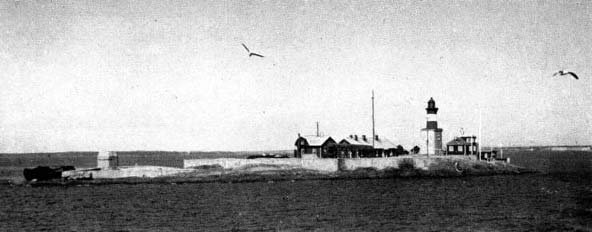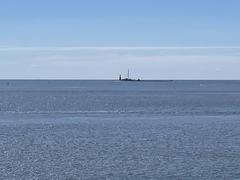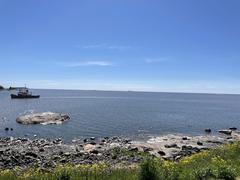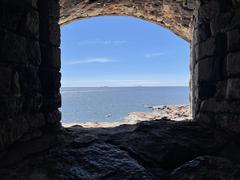
Harmaja Visiting Hours, Tickets, and Guide to Helsinki Historical Sites
Date: 15/06/2025
Introduction to Harmaja: History and Cultural Significance
Harmaja Island, situated just south of Helsinki near the renowned Suomenlinna sea fortress, stands as an emblem of Finland’s maritime heritage and natural beauty. Its iconic lighthouse, first constructed in the late 19th century, was further distinguished in 1936 when Harmaja became home to the world’s first combined directed and undirected radio beacon—an innovation in maritime navigation (fi.wikipedia; danstopicals.com). Although the island itself is generally closed to the public due to its operational role as a lighthouse and weather station under the Finnish Transport Infrastructure Agency, visitors can experience its maritime significance through boat tours and sightseeing cruises departing from Helsinki (myhelsinki.fi; Evendo). This comprehensive guide details Harmaja’s history, accessibility, visiting options, nearby attractions, and practical travel tips, ensuring a well-prepared and memorable journey into Helsinki’s maritime legacy.
Table of Contents
- Early Origins and Maritime Beginnings
- Development of the Lighthouse
- Harmaja’s Role in Finnish Maritime History
- Social and Cultural Impact
- Notable Events and Transformations
- Visiting Harmaja: Hours, Tickets, and Accessibility
- Nearby Attractions and Travel Tips
- Visuals and Media
- Frequently Asked Questions (FAQ)
- Legacy and Continuing Significance
- Practical Visitor Guide and Recommendations
- References and Useful Links
Early Origins and Maritime Beginnings
Known in Swedish as Gråhara, Harmaja’s strategic location at the entrance to Helsinki’s harbor has made it vital for maritime navigation for centuries. Records suggest the first navigational marker—a simple sailing mark—was erected as early as the 16th century to assist ships maneuvering the challenging Gulf of Finland (fi.wikipedia). This early aid reflects the Helsinki region’s deep-rooted seafaring culture, with local traders and peasants historically transporting goods across the Baltic Sea, notably to Tallinn (myhelsinki.fi).
Development of the Lighthouse
Following Helsinki’s designation as the capital of the Grand Duchy of Finland in 1812, maritime traffic increased, necessitating enhanced navigational aids. The 18th-century daymark on Harmaja gave way to a 7.3-meter lighthouse in 1883, which was soon raised atop a granite and brick base to improve visibility. The French-made, petroleum-powered lantern equipped with a Fresnel lens marked the cutting edge of its era, while a powerful foghorn enabled safe passage during low-visibility conditions (danstopicals.com). These advancements ensured Harmaja’s status as a crucial component in Helsinki’s maritime safety network.
Harmaja’s Role in Finnish Maritime History
The lighthouse’s construction and subsequent technological advancements cemented Harmaja’s role in Helsinki’s rapid 19th- and 20th-century growth as a commercial and industrial center. Ships from fishing boats to passenger steamers relied on Harmaja for safe passage, especially during periods of political transition and conflict, such as Finland’s shift from Swedish to Russian rule and eventual independence (sail-in-finland.info; ibiblio.org). The installation of the pioneering radio beacon in 1936 advanced maritime navigation worldwide, underlining Finland’s commitment to innovation (danstopicals.com).
Social and Cultural Impact
Harmaja’s significance extends beyond navigation. Its surrounding waters have long been a hub for yachting and sailing, with the Nyländska Jaktklubben (NJK) yacht club founded nearby in 1861. The area became central to regattas and boating events, further integrating Harmaja into Helsinki’s maritime culture. Historic photographs from the 1930s showcase fleets of yachts and steamers against Harmaja’s silhouette, highlighting its role in the city’s social life (sail-in-finland.info).
Notable Events and Transformations
Throughout the 20th century, Harmaja was pivotal for both civilian and military navigation. It has hosted international lighthouse and lightship weekends, notably in 2004 and 2014, when amateur radio operators established connections with enthusiasts worldwide (fi.wikipedia). Periodic renovations have preserved its structural integrity and adapted its technology, ensuring its continued relevance.
Visiting Harmaja: Hours, Tickets, and Accessibility
General Access
Harmaja is not open to the public due to its operational status. There are no regular visiting hours or direct ticket sales for independent visits. However, its lighthouse and landscapes can be admired from boat tours and sightseeing cruises in Helsinki’s archipelago. These tours provide excellent photo opportunities and a unique perspective on the harbor (Evendo).
Boat Tours and Cruises
- Season: May through September is ideal, with frequent boat departures.
- Tickets: Boat tour prices vary, generally starting at €10–€15 round trip.
- Booking: Reserve early during summer weekends; check weather and tour schedules in advance.
- Accessibility: While the island cannot be landed on, most boats are accessible to families and those with limited mobility.
Nearby Attractions and Travel Tips
Harmaja’s proximity to other maritime sites makes it an excellent waypoint for broader exploration:
- Suomenlinna Sea Fortress: UNESCO World Heritage site, accessible by ferry from Market Square.
- Lonna and Vallisaari Islands: Known for their history, nature, and leisure facilities.
- Helsinki South Harbour: Bustling with restaurants, museums, and ferry connections.
Travel Tips:
- Dress in layers and bring waterproof clothing.
- Carry water, snacks, binoculars, and a camera.
- Public transport is recommended to the ferry terminal due to limited parking.
- Always check weather forecasts before booking boat tours.
Visuals and Media
Enhance your planning with:
- High-resolution images of Harmaja lighthouse and the surrounding seascape (use alt text like “Harmaja lighthouse Helsinki” for SEO).
- Interactive maps of the Helsinki archipelago, highlighting Harmaja’s location.
- Virtual tours and galleries from official Helsinki tourism websites.
Frequently Asked Questions (FAQ)
Q: Can I visit Harmaja Lighthouse in person?
A: The island is not open to the public, but the lighthouse can be viewed from sightseeing cruises.
Q: Are there entrance fees for Harmaja?
A: No entrance fees for the island, but boat tour tickets typically cost €10–€15.
Q: What’s the best time to see Harmaja?
A: Late spring through early autumn offers the best weather and frequent tours.
Q: How do I get there?
A: By organized boat tour or cruise departing from Helsinki’s harbor.
Q: Is Harmaja still an active lighthouse?
A: Yes, it operates as a lighthouse and weather station.
Legacy and Continuing Significance
Harmaja is inseparable from the development of Helsinki’s maritime identity. From its beginnings as a 16th-century marker to its role in global navigation technology, the island reflects Finnish innovation and resilience. Even as public access is restricted, Harmaja remains a powerful symbol of Helsinki’s enduring relationship with the Baltic Sea (myhelsinki.fi).
Practical Visitor Guide and Recommendations
- When to Visit: May–September, aligning with boat tour operations.
- How to Prepare: Dress for changing weather, bring essentials (food, water, camera).
- What to Expect: Unforgettable views, historic context, and the opportunity to combine your visit with other Helsinki maritime sites.
For up-to-date schedules and tickets, refer to MyHelsinki and Evendo.
References and Useful Links for Harmaja Visitors
- Harmaja Lighthouse: Visiting Hours, Tickets, and Helsinki’s Historic Maritime Landmark (fi.wikipedia)
- Finnish Lighthouses and Harmaja Radio Beacon, Dan’s Topicals
- History of Helsinki and Maritime Heritage, MyHelsinki
- Harmaja Island Visitor Information, Evendo
- Helsinki’s Islands and Ferries, MyHelsinki
- City of Helsinki Nature Conservation
- Where and When: Helsinki June Climate
Harmaja Island is a living testament to Helsinki’s seafaring history and technological progress. While access is limited, its lighthouse and maritime legacy continue to inspire visitors and locals alike. Plan ahead, respect local guidelines, and savor the unique charm of Helsinki’s lighthouse gateway.






























































































































































































































